Monuments in Bradford Cathedral
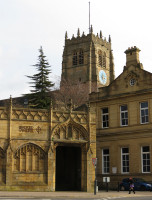 16th Century tower of Bradford Cathedral.
16th Century tower of Bradford Cathedral.
Bradford Cathedral was once St Peter, Bradford’s Parish Church, enlarged in the mid-20th Century after it achieved
Cathedral status following World War I. The oldest part is the nave, with arcading of the 14th Century,
and the tower is of the late 15th/early 16th Century. It is this tower which, low though it is,
can be seen from some considerable distance and vantage from across the city, a mellow-coloured, buttressed and
crocketed thing with a double pair of Gothic windows on each side. The view from close by is mostly of the 1950s
extension, widening and lengthening the church. The porch however is early 19th Century.
The small churchyard is atmospheric: many monumental slabs laid flat to form a pavement, with a few still standing.
An interesting time can be had perusing thsee lain-down slabs, most of which are in clearly cut script,
and date from the 18th Century, with a few from earlier.
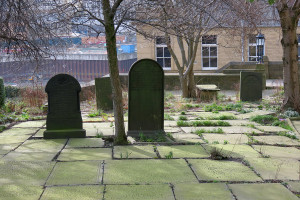
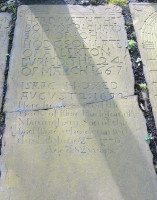 The pavement of gravestones, and a 17th Century example.
The pavement of gravestones, and a 17th Century example.
Inside the impression is of length and height of the nave, the roof being a wooden construction of the 18th Century,
though the various little angels forming corbels are mid-Victorian. The modern part, especially to the rear of the altar,
is well done, but spare, plain and clean, and hopefully the next century or so will see the emplacement of lots more
monuments and antiquities than it has at present.
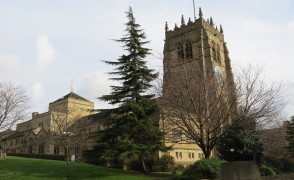
The oldest relic in the Cathedral is a small piece of Saxon cross set into a wall. This is rare enough that it needs
to be seen despite its fragmentary state. It shows the usual carved scrolling with loops over and under,
but not enough to see a whole design. But we are here to see the monuments, of which the Cathedral has a large collection,
almost exclusively wall plaques. There are about 60 in all, about half of which are 18th Century – a very good spread –
and most of the rest from the earlier 19th Century. The several 20th Century plaques are accompanied by war memorials
and a few modern panels to various events. Features of the collection are eight or nine ‘obelisk monuments’,
thus with the upper backing styled as a tall obelisk on which some element, typically a Greek pot on a base, is emplaced.
There are a few monuments with nicely carved figures, and rather more with cherubic heads, carved drapery and plants,
naturalistic and stylised. In terms of masons and sculptors, we can see examples both of several Yorkshire firms –
which because of the importance of York are of more significance than most local schools of mason-sculptors –
and a few by national names, including Scheemakers, Flaxman, Joseph Gott
and Bacon the Younger.
They are described, as usual on these pages, in date order.
18th Century Monuments
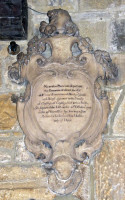
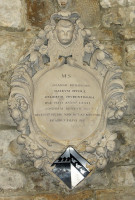 1700s cartouches: Monuments to Sarah and Susannah Richardson.
1700s cartouches: Monuments to Sarah and Susannah Richardson.
- Sarah Richardson, d.1703, heiress apparent to the family of Crossley, of Crossley Hall, and infant son.
A most excellently designed cartouche, with elegant scrolling at the sides and top, Acanthus, flowers, a shield at the top with piercings
on either side, this having a small pot on top, and at the bottom, a winged cherubic head.
- Benjamin Baron, d.1705, Vicar of Bradford, and children Benjamin, d.1701
and Esther, d.1704. Curved panel with sides draped, three winged cherubic heads, shield and knight’s helm
with leaves, painted in various colours.
- Susanna Richardson, d.1708. Stone cartouche with surround of palm leaves, flowers and fruits,
with a winged cherubic head at the top and a coat of arms at the bottom.
Carefully carved with much undercutting and cut-through sections.
- Martha Rawson, d.1708, wife of William Eawson of Bradford, Gent. An incomplete piece,
with the inscription surrounded by leaflets, flower garlands above, and a little shield at arms showing the castle emblem,
see Grace Rawson monument below. Painted, which works poorly on the two cherub heads at the base of the fragment.
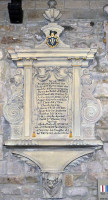
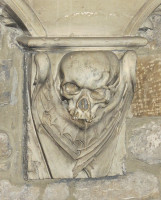
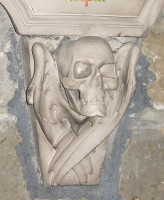
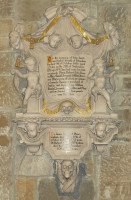
Monuments to Faith Sharp and John Smyth, 1710s, and their carved skulls with bat wings.
- Faith Sharp, d.1710, wife of Thomas Sharp, d.1693 who died at Leeds and was buried there.
The earliest of a series of monuments to members of this family. Also son John Sharp, d.1704,
‘student in Physick at Leyden in Holland’, and daughter Elizabeth, who married Robert Stansfield of Bradford.
The inscription on a panel with knotted drapes around, side pilasters outside which are scrolly side pieces with Acanthus fronts
and cherub heads, all supporting a heavy entablature on top of which is a curved structure supporting a shell-like pot,
and on which is a coat of arms. It looks as if there may have been further adornments on top.
At the base, a curved apron at the base of which is a single bracket incorporating a fierce skull with folded bat wings.
- John Smyth, d.1686, and wife Isabel of Miryshaw, d.1711, and listing 10 children.
A cartouche as if on a drape, hanging from large knots at the sides, and with two winged cherub heads above centre,
the drapes rising above this to a third knot. A bit of carving above this looks like the central portion of a curved pediment,
and I would think that originally there was a pierced pediment down to the side knots.
To left and right of the central field lively putti are seated on pedestals, disproportionate little things,
heads pushing up the drapery. The lower fringe of the drapery is pushed up by a skull. Under all this, a scallop-edged shelf,
under which are supports bearing further angel heads, and a central inscription recording the death of James Smyth of Manningham,
d.1720, and Richard Smyth of Miryshaw, d.1721. At the very bottom, a further skull, with crossed bat wings
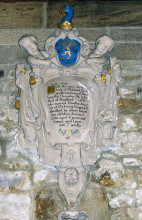 David Poole, d.1712, with finely carved drapery.
David Poole, d.1712, with finely carved drapery.
- David Poole, d.1712, and two infant children. The inscription notes he was an apothecary,
born at Barrstone Ash, died in Bradford. Stone cartouche with much hanging drapery at the sides and two cherubic heads,
upper shield of arms with scrolly surround and peacock’s head, all held by two cherubs, of whom we see the upper bodies and heads
peeking up behind the main panel. At the base, a single bracket as a forward-facing skull with folded bats wings.
- Thomas Wood, d.1712, brass oval, longer than it is tall, with Latin inscription,
and border of repeating stylised flowers. Placed on a modern light marble backing.
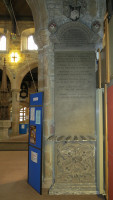
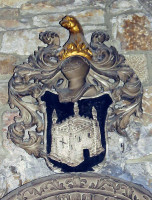 Grace Rawson Monument, d.1737, and coat of arms with castle.
Grace Rawson Monument, d.1737, and coat of arms with castle.
- Grace Rawson, d.1716, husband William Rawson of Bradford, d,1737,
and family to 1767. Tall wall panel with curved panel on top, with inscription to Grace Rawson, the others below.
A repeating pattern is carved on the upper frame, which is flanked by two plump pots with coats of arms,
and a central shield showing a castle in low relief with the usual knight’s helm on top, with feathers and a summit bird’s head.
The inscriptions are in Latin. At the base, a square panel with relief skull and crossbones,
vigorously rendered amongst frondy leaves in a sort of strapwork.
- John Stanhope of Eccleshill, d.1710, and wife Elizabeth, d.1717, and family to 1787.
An obelisk monument, with the inscription occupying a while shaped panel occupying the whole lower portion.
Above the shelf at mid way, the obelisk shaped backing, in grey marble with white streaks, has upon it a relief of a Greek pot
on a tall base. The pot is decorated with leaves from the base, a medallion, and symmetrical twist of drapery, and the base with a
ribbon and blank circlet.
- Thomas Clapham, d.1719, in Roman numerals oddly written, scholar and Magistrate,
with a long Latin inscription. Tall panel, with shelf at top, and the side borders missing, and on top,
a painted shield of arms with ribbon, floralities and knight’s head, and underneath, a further shelf, two scrolly carved supports,
apron, and upon it, a brass roundel with curly script which I could not easily read, and the date 1708.
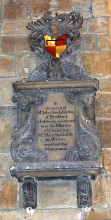
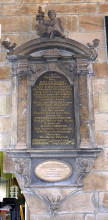
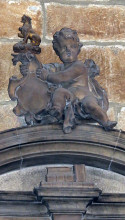 Early 18th Century Baroque: Stockdale and Midgley plaques.
Early 18th Century Baroque: Stockdale and Midgley plaques.
- John Stockdale of Ardford, d.1724, the monument erected by his wife Mary.
With ornately carved surround to cntral panel, acanthus leaves and scrolling. Upper shelf bearing flowery, scrolly, curved top
like a pediment without border, supporting a shield of arms with much feathery ornament around it from the knight’s helm on top.
Heavy shelf with brackets below, between which is nothing; there may have been an apron at one time.
- John Midgley, d.1730, and Bathsheba, d.1736, wife of John Hollings of Croxley Hall,
and relatives. Black panel curved at top, with yellow marble side pilasters, ionic, spandrels with winged cherubic heads,
and entablature above, supporting a curved pediment. Within this is a carved heap of books, and seated above,
is a pump putto holding a cartouche to one side, which presumably once bore a coat of arms. Small flaming pots at the corners.
Below, a smaller oval panel on a black base records the death of Maria of Little Horton and Martha d.1762
and 1778 respectively. The depth of the panel allows for large carved brackets.
- William Bolling of Manningham, d.1730, and John Bolling of Chellow, d.1729, put up 1752.
Plain stone shaped monument with thin border, a few carved leaves at the top, and a carved scallop shell at the base.
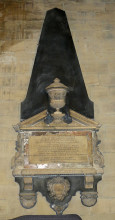
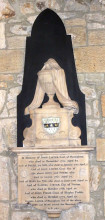 1730s obelisk monuments to Isaac Hollings and John Lister.
1730s obelisk monuments to Isaac Hollings and John Lister.
- John Lister, d.1734, gentleman of Mannington, wife Phebe, d.1743, son
John, etc, to 1787. Another obelisk monument, this time with the shaped backing only on top.
With a second tier pedestal, bearing a shield, supporting an asymmetrically draped pot.
The Lister family too is represented later on among the monuments.
- Isaac Hollings of Shipley, d.1734, erected by wife Mary. Rich obelisk monument.
The inscription is within a coloured marble border, with receding scrolly side pieces, an enriched pediment,
broken at the top to allow for a a large decorated pot with carved flowers around it. Behind, a tall obelisk in black marble.
Below, a curvaceous apron in black, with central cartouche of arms, now blank, delicately carved with acanthus leaves.
To the sides, upper and lower brackets, the lower ones with scallop shells, and a central lower boss.
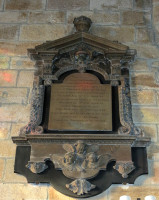
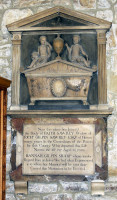 Clustered cherub heads on the Swain monument, and mourning cherubs on the Faith Sawrey monument.
Clustered cherub heads on the Swain monument, and mourning cherubs on the Faith Sawrey monument.
- Wiliam Swain of Bradford, d.1737, and family through to 1733. Monument erected by Mary and Elizabeth Swain,
co-heiresses of the family. Panel with curved top, black surround, then a complex carved frame in pale stone with leaves, balls,
flowers etc. Above, short receding pilasters support an open pediment enclosing a carved coat of arms in a cartouche.
And on top of all, a small pot with carved flowers; bases to the sides suggest some small devices may have once been present.
The baroque apron below is supported with three Acanthus leaf corbels, nicely carved, and in the centre is a group of three winged
cherubic heads.
- Nathan Jowett, d.1739, of Eccleshill, wife Susannah, d.1737, and descendents through to 1816.
Tall panel with plain stone border, on top of a panel with dark marble surround and shelf, as if a coffer chest end,
and upon it in high relief, a winged cherubic head and crossed palm fronds, carved to a weight and solidity in keeping
with the size of the monument.
- Abraham Sharp, d.1742, with long Latin inscription, and note at the bottom it was put up by Francesca Sawrey,
presumably a relative of the Faith Sawrey noted below. Panel with receding side pilasters resting on scrolls,
upper open curved pediment enclosing a shield at arms in a cartouche, and at the base, a separate panel with a low relief carving
of what seems to be a gemstone, setting and lapidary tools. Signed by the important sculptor Peter Scheemakers
[signed here without the final ‘s’, not uncommon]. This shows several of Scheemakers’ favoured ornaments,
for example the shape of the scrolling outside and recessed from the pilasters. His most famous work, of course,
is the statue of Shakespeare in Westminster Abbey, copied in the figure standing in Leicester Square.
- Mary Field, d.1751, husband John Field, d.1772, six unnamed children,
and son Joshua Field, d.1819, and his wife Mary Field, d.1830,
the different texts indicating that the monument was put up after the death of the elder Mary Field (1751).
Arched tablet with border, pilasters Left and right, carved with hanging flower design, supporting open pediment
with a discoloured patch where a shield or cartouche would have been affixed within it.
Small pot above, roundel apron below between two fluted, curled brackets. This apron bears a roundel containing a winged hourglass;
an acanthus terminus below.
- Faith Sawrey, d.1767, erected by Hannah Gilpin Sharp. Panel with alabaster surround,
above which is a carved casket tomb with two mourning cherubs reclining on top, and a central pot, delicately carved,
all within side pilasters under a blank pediment. One cherub gestures towards the pot, his other hand resting on some tool;
the other dries his eye with one corner of his cloak, while his other arm rests on a skull.
The sculptor was John Francis Moore, a significant figure, responsible for the showy monument to William Beckford in the Guildhall, London.
- Hardy, Annis, d.1774, and Mary Hardy, d.1804, successfive wives of John Hardy, d.1806.
Panel with upper shelf, lower brackets carved with stylised flowers and leaves, and central curve in lieu of an apron,
on a black backing.
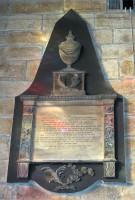
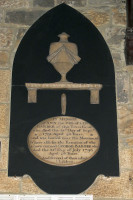 Monuments to Mary Hodgson, d.1776, and Ann Barber, d.1791.
Monuments to Mary Hodgson, d.1776, and Ann Barber, d.1791.
- Mary Hodgson, d.1776, husband John Hodgson of Brierley, d.1790, and relatives. White panel,
coloured marble side pilasters, upper shelf supporting entablature and shelf with short black obelisk shape above,
on which is a pot resting on a base with crossed palm leaves. On apron below, crossed oak and palm leaves.
- Revd. Bejamin Kennet, Vicar of Bradford, d.1752, and his third wife Mary, d.1754,
put up by their daughter Hannah Kennet in 1777. Roundel within a black rectangle, with shelves below and above, no side pieces,
though these may well have once existed, a particularly elegant pot, partially draped and with narrow base, above,
and at the base, a cartouche, now blank.
- John Bailey, d.1789, wife Judith, d.1812, and family to 1851, in black letter text
on a gently arched marble panel with stone surround with minor carving on borders etc.
- Harriett Henrietta Jones, d.1791, brother James Jones, d.1795,
sister Elizabeth Dixon Jones, d.1802, and their father Thomas Jones, d.1903, surgeon,
and his wife, Elizabeth Jones, d.1815. Square panel with nipped corners on black backing with upper shelf
and small brackets below.
- Mary Newmarch, d.1791, husband Major Newmarch, d.1802,
‘Captain in the 7th Regiment of Foot in the American War, and promoted to a Majorry for is meritorious services while in America’,
and son Alexander, Captain in the 17th Regiment of Foot, who died at St Domingo, 1796.
Plain panel with black surround, but with beautifully cut text.
- Ann Barber, d.1791, and husband George Barber of Bradford, d.1796,
and several of their infant children. An unusual composition (picture above), with the inscription in an oval, with above it a single thin drape,
then a shelf on which sits a pot, these elements being separate from one another, all attached to a black backing cut to a Gothic window
shape and with an apron. I have seen extraordinarily few monuments with such separated parts, and it may be that this
was a more conventional Classical monument of which the other parts have been lost and the remainder reset. Or not.
- Samuel Lister of Manningham, d.1792, monument erected by his wife Mary the following year.
Obelisk monument, with second stage, tall pot, and underneath on the apron, a drape hanging from two knots. Signed by
William Stead of York.
- Young children of William and Alice Barwick of Bradford, who died in 1788 and 1796,
and Alice, d.1814, William, d.1833, plain panel with nicely cut lettering,
and which probably once had a surround.
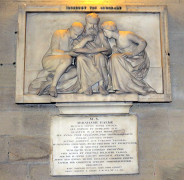
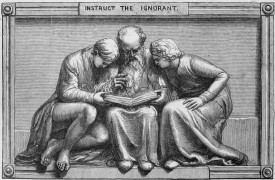 Flaxman panel to Abraham Balme.
Flaxman panel to Abraham Balme.
- Abraham Balme, d.1796, with Latin inscription, plain panel, with above, a fine panel showing the deceased
as an elderly scholar with full beard, dressed in Greek costume, seated and reading from an open book.
He is accompanied by two figures, male and female, who look at his book and lean in from left and right.
The young man, presumably a son, holds one edge of the book, and is wearing lightly sketched in modern collar and some sort of
light sleeved garment, though his legs are bare. The woman on the other side, presumably his wife,
is shown as a youthful figure with again a mix between contemporary clothing, with tight-fitting top and sleeve, and classical,
with her long skirts more drapery than clothing per se, thogh a modern shoe peeps out underneath.
The faces are a little soft and less hard than they might be. Above, on the frame, is the admonition ‘Instruct the ignorant’,
so perhaps the two subsidiary figures are in fact students. The sculptor is the eminent John Flaxman;
a drawing exists for this design showing some differences in the placing of the drapes.
The work is typical of Flaxman in its purity and the careful simplicity of the design.
See also the later monument to John Balme, d.1813.
19th Century Monuments
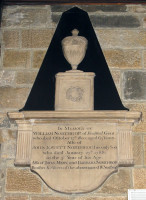
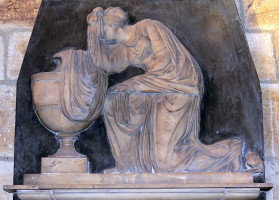 William Northrop by John Bacon Jr, and mourning girl by W. & R. Fisher of York.
William Northrop by John Bacon Jr, and mourning girl by W. & R. Fisher of York.
- William Northrop, of Bradford, Gent, d.1800, and son John Jowett Northrop, d.1788,
and the father's brother and sisters. Stone panel with fluted side pilasters, shelf, and above it, a relief of a pot upon a tall base,
all on a black obelisk shaped backing. The pot has the leaves, roundel and twisted drapery seen already,
for example on the John Stanhope monument noted above, and the base bears a wreath of olive leaves in low relief.
Signed by Bacon [the younger], 1804, one of the most prolific statuaries of his time.
- Mary Jarratt, d.1800, infant children, and nephew William Stanley Jarratt, d.1812.
Panel with borders, thin inlay, fluted upper and lower shelf and small apron, and three small carved flowers.
- Frances Rawson, d.1801, wife of Jeremiah Rawson of Bradford. She was also daughter of Richard Sterne of Elvington,
and his son Timothy Sterne of Woodhouse, d.1746, and other daughter Dorothy Lister, d.1756,
are also commemorated. Panel with carved frame, with many flowers and leaves in high relief, small pot, etc.
At the top, a relief pot, partially and asymmetrically draped, on an obelisk backing with the downward flying dove we have seen
in other monuments in the church, and on the apron, a lozenge painted with a coat of arms.
- Maria Lister, d.1809, with Latin inscription. Fluted pilasters, and a sculpture above the upper shelf,
of a mourning girl kneeling and leaning against a draped pot. Ambitious drapery, well executed,
and unusually concealing much of her face. The black backing, which rises in a sort of curvy obelisk shape,
has upon it a swooping dove, again carved in white marble. Beneath the panel, two brackets and a lozenge coat of arms,
now plain, emerging from a draped excrescence. Signed by W&R Fisher, York – an example of the quality that this firm could produce.
- John Balme of Bradford, d.1813, sister Sarah Balme, d.1828,
Samuel Broadley of Bradford, d.1825, and wife Elizabeth, d.1826, sister of John Balme.
All on a panel with blank eared pediment. Beneath, on the same black backing, but more ornately on a casket with fluted ends and elegant
shape and resting on lion feet on a shelf, is an inscription to William Bacon of Wolverhampton, and wife Mary,
d.1853, another Balme sister. Beneath all this, a carved shield at arms with a pig on top.
At the top, a sculpture of a down-flying dove. Signed indistinctly by a York sculptor.
- Thomas Mann of Mannville Horton, d.1814, children Eliza, d.1819,
Thomas, d.1841, and wife Betty, d.1843, and infants.
Conventional white marble plaque with top cut to eared pediment shape, with swirly relief which may be a very stylised plant.
At the base, an oval containing light reliefs of olive and palm fronds tied together.
All on a black backing, and looking as if it once had two brackets or feet, now lost.
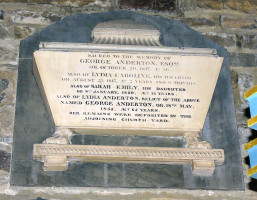
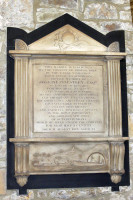 Anderton and Priestly monuments, both d.1817, the latter by William Pistell.
Anderton and Priestly monuments, both d.1817, the latter by William Pistell.
- George Anderton, d.1817, daughter Lydia Caroline, d.1817,
and in a later script, another daughter, Sarah Emily, d.1830 and wife, Lydia Anderton, d.1855.
Inscription on panel as a casket with lion feet, standing on a nice shelf, and with a baroque lid.
All on a dark, streaky marble backing. Signed indistinctly by a New Road [London] sculptor.
- Children of Samuel Hailstone and wife Ann Hailstone, d.1816, 1816,1824,
plain white marble panel with upper shelf and lower feet, on a streaky marble backing.
- William Ward of Bradford, d.1819, William Mann of Bradford, d.1814, and his sister
Sarah Ward, wife of William, d.1833, and other members of the family through to John Ward of Bradford,
gentleman, d.1841. Tall panel with eared pediment and pot in low relief, on black backing.
- Joseph Priestley, d.1817, placed by the Company of Proprietors of the Canal Navigation from Leeds to Liverpool,
superintendent to Company for near half a century. Square panel with side pilasters, upper pediment without much of a frame,
but with acroteria, and in the centre, a low relief group of draghtsman’s tools. Under the panel and a lower shelf,
between curved brackets is a low relief scene of the canal being dug and a ship, most unusual - see picture above. (Ships in general, however,
are fairly common in architectural sculpture, and not unusual on monuments - see this page.) On a black shaped backing.
The sculptor was William Pistell, of New Road, London.
- Ann Paley of Bowling and Langcliffe in Giggleswick, d.1823, and young son William, d.1822.
Panel as tomb chest end, with upper shelf, festooned hanging, lion-footed casket on top, which has upon it a relief of a flowering plant.
All on a black backing.
- Anne Wood, d.1828, casket tomb end on a black panel.
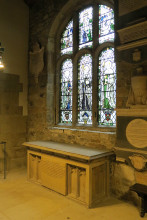
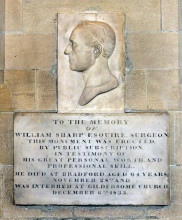 Chest tomb to Margaret Mason, d.1829, and Joseph Gott's portrait of William Sharp, d.1833.
Chest tomb to Margaret Mason, d.1829, and Joseph Gott's portrait of William Sharp, d.1833.
- Margaret Mason, d.1829, as a tomb chest against one wall, with paired blind windows, a heavy top,
and minor carving of flowers just under this. How odd to have a monument like this in that century.
- William Sharp, d.1833, surgeon, plain panel with a bust in high relief. Good quality early 19th Century work,
showing a sensitively modelled face of a cerebral personage. There was probably once a surround.
The sculptor was Joseph Gott, an important artist, known more for his statues than monuments, though there
is a fine monument by him to Thomas Lloyd in Leeds Parish Church.
- Anne Sharp, d.1834, wife of William Sharp, surgeon, noted above, and their daughter,
Annie, d.1846. Plain plaque on black backing.
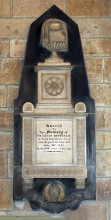 Matthew Skelton of York's monument to Francis Duffield, d.1841.
Matthew Skelton of York's monument to Francis Duffield, d.1841.
- Francis Duffield of Town Hill House, d.1841. Tall obelisk monument - really rather late for this type of memorial - the black obelisk backing seen all the way
round. White marble panel with frame and upper shelf supporting second tier, acting as base of a draped pot.
At the base, a carved shield of arms encircled with two branches of bunched leaves, on stalks which are twisted elegantly together.
A ribbon bears the single word Fidelis [faithful], but the other side of the ribbon is lost. There is an indistinct signature,
by Matthew Skelton of York. His best monument which I have seen is in York Minster, to Christopher E.T. Oldfield,
with a wonderfully spiky architectural trophy behind the top.
- Richard Wood, d.1842, and a young daughter d.1846 in a later inscription.
As a casket tomb end with side pilasters, upper and lower shelf, eared pediment above, lion feet below and standing upon a shelf
with two brackets with carved acanthus leaves. All on a grey, brecciated marble backing.
- Revd. John Crosse, Vicar of Bradford, d.1818 but the monument erected ‘by his surviving friends’
a quarter of a century later in 1843, tall panel with blank pediment on top, and large anemone design acroteria, and a chunky base.
Under this are two supports, rounded off, bearing roundels with stylised sunbursts. All on a black backing.
Signed indistinctly by F(?). Webster
- John Bower of Townend Bradford and Middlethorpe Hall, d.1843, and wife Anne, d.1853,
and son Abraham Bower of Elmcrofts, d.1884. As a mildly Gothic panel with darker surround,
between panelling as blank trefoil windows.
- William Pollard, d.1840, and wife Beatrix, d.1847, small brass with red initial letters
and numbers, rest black. See below.
- Willson Cryer of Bradford, d.1853, as an obelisk on a shelf with narrow black backing,
cut shapes rather than carving.
- Jonathan Akroyd Illingworth of Bradford, d.1854, surgeon. Black letter inscription on a small shield
with coat of arms above supported on two stylised shells; carved scallop shell below.
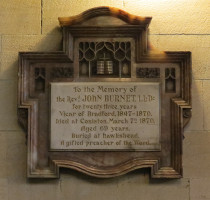
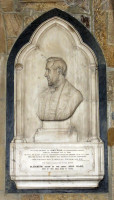 1870s plaques: Revd John Burnett and John Rand.
1870s plaques: Revd John Burnett and John Rand.
- Revd John Burnet, d.1870, Vicar of Bradford. A colourful little monument,
the central panel enclosed by an outer border of varying widths, as if a squat crucifix had been embedded in the top,
and with the bottom corved, and all framed. The central area above, and to the sides, is cut out as if window tracery,
with the main feature being a little open bible in front of a crucifix, and leaves.
- John Rand, of Manningham Thorpe, d.1873, and wife Elizabeth, d.1883.
Above the panel is a tall trefoil Gothic window, with a relief bust of the deceased in profile on a pedestal.
He is shown elderly, bearded, and with cavernous eye beneath heavy brow and a high forehead - see picture above.
- William Pollard, d.1819, wife Susanna, d.1877, put up in 1882 by daughter Sarah Jane Bond.
Brass with black letter, red capitals and thin border in a style common in the later 19th Century.
- Revd. Vincent William Ryan, d.1888, Vicar of Bradford, and previously first Bishop of Mauritius.
Charming little monument after that to John Burnet above, with complex border ,coloured marble, mire in a small window above.
20th Century Monuments and other items
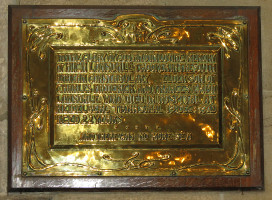 Art nouveau beaten metal tablet to Hugh Lonsdale, d.1902.
Art nouveau beaten metal tablet to Hugh Lonsdale, d.1902.
- Hugh Lonsdale, d.1902, brass with 1900s text and art nouveau design.
He was a trooper in the South African constabulary, and died in Heidelberg, Transvaal. Elegant.
- Hannah Lambert, d.1911, plain plaque with red-brown alabaster frame, characteristic of the times.
- Private Eric Anderson VC, d.1943, of the East Yorkshire Regiment. Plain panel with tiny coat of arms
of the regiment.
- James Joseph Magennis VC, plaque 1945, plain with regimental coat of arms.
As noted at the beginning, there are a number of other late 19th/20th Century items, of which we note the following:
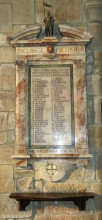
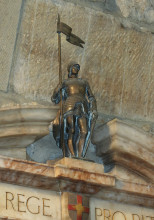
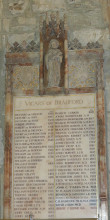
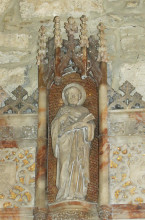 World War I monument, and Roll-call of Vicars, and their small statues.
World War I monument, and Roll-call of Vicars, and their small statues.
- Model of Church by William Ogg, 1898, when still the Parish Church, showing the proportions
before it was enlarged to form the Cathedral.
- World War 1 Memorial, colourful alabaster with fluted side pilasters, entablature and broken,
curved pediment containing a small statue of a knight in armour holding a standard.
- Panel to Burma Campaign World War II, emplaced 2004, plain panel with regimental arms.
- Brass with note that the tenor bell in the tower was given in memory of Captain John Alfred Emsley, d.1918,
with inscribed angels above the text.
- Vicars of Bradford from 1293 to the present on panel with colourful alabaster surround with shields
and minor carving and small central saint above, and in nice crocketed niche with gold mosaic. Gothic at the top.
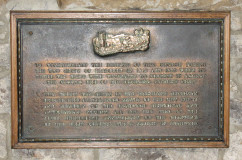
Modern plaque: 1951 commemoration of Defence from the Royalists.
- 1951 brass panel to commemorate defence of the Church in 1642 and 1645 from the Royalists,
with a small low relief moulding of the church.
- Little panel to Bradford Police, 1974, with two small brass badges.
- Freedom for Nations and Freedom for Individuals, plaque unveiled by Yaroslav Stetsko,
president of the Anti-Bolshevik bloc of nations, 1983, for the captive nations of Byelo-Russia, Estonia, Hungary, Latvia,
Lithuania and Ukraine, plain plaque with flags, cross and a small device of a sword striking the chain binding a pair of hands.
For those interested in Ukraine, in London is the statue of
St Volodymyr – see this page.
- Roundel plaque commemorating the Bradford Disaster Appeal after a fire at Bradford City Football Ground in 1985,
crisply cut script on blueish backing.
- Robert Lowry Turner d.1990 and George Whyte Watson, d.1974,
plaque to commemorate their work in Bradford in using chemotherapy for cancer treatment.
Inscription in an oval within a plain rectangular panel.
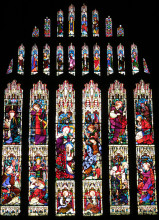
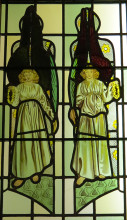 Example of stained glass in the Cathedral, and two of the Pre-Raphaelite angels.
Example of stained glass in the Cathedral, and two of the Pre-Raphaelite angels.
We should also notice the large coat of arms, heavily painted, against one wall. With carved lion and unicorn (for pictures of unicorns, including on
coats of arms, see this page).
Perhaps 18th Century? Also the font with its grand cover, with four carved saints.
The stained glass is good, and includes some work by William Morris and company;
note particularly the characteristic Pre-Raphaelite angels (picture above).
With many thanks to the authorities at Bradford Cathedral for their kind permission to use pictures from inside the Cathedral;
see their website at http://www.bradfordcathedral.org/the-building/history/.
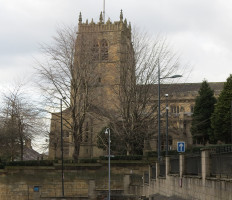
Top of page
Introduction to Bradford // Bradford City Hall // Victoria Square statues
Angel statues // Cherub sculpture // Introduction to church monuments
Sculpture in England // Sculpture pages
Home
Visits to this page from 4 April 2014: 15,091
 16th Century tower of Bradford Cathedral.
16th Century tower of Bradford Cathedral.
 16th Century tower of Bradford Cathedral.
16th Century tower of Bradford Cathedral.

 The pavement of gravestones, and a 17th Century example.
The pavement of gravestones, and a 17th Century example.

 1700s cartouches: Monuments to Sarah and Susannah Richardson.
1700s cartouches: Monuments to Sarah and Susannah Richardson.

 Grace Rawson Monument, d.1737, and coat of arms with castle.
Grace Rawson Monument, d.1737, and coat of arms with castle.

 Clustered cherub heads on the Swain monument, and mourning cherubs on the Faith Sawrey monument.
Clustered cherub heads on the Swain monument, and mourning cherubs on the Faith Sawrey monument.

 William Northrop by John Bacon Jr, and mourning girl by W. & R. Fisher of York.
William Northrop by John Bacon Jr, and mourning girl by W. & R. Fisher of York.

 Anderton and Priestly monuments, both d.1817, the latter by William Pistell.
Anderton and Priestly monuments, both d.1817, the latter by William Pistell.

 Chest tomb to Margaret Mason, d.1829, and Joseph Gott's portrait of William Sharp, d.1833.
Chest tomb to Margaret Mason, d.1829, and Joseph Gott's portrait of William Sharp, d.1833.
 Matthew Skelton of York's monument to Francis Duffield, d.1841.
Matthew Skelton of York's monument to Francis Duffield, d.1841.
 Art nouveau beaten metal tablet to Hugh Lonsdale, d.1902.
Art nouveau beaten metal tablet to Hugh Lonsdale, d.1902.



 World War I monument, and Roll-call of Vicars, and their small statues.
World War I monument, and Roll-call of Vicars, and their small statues.

 Example of stained glass in the Cathedral, and two of the Pre-Raphaelite angels.
Example of stained glass in the Cathedral, and two of the Pre-Raphaelite angels.